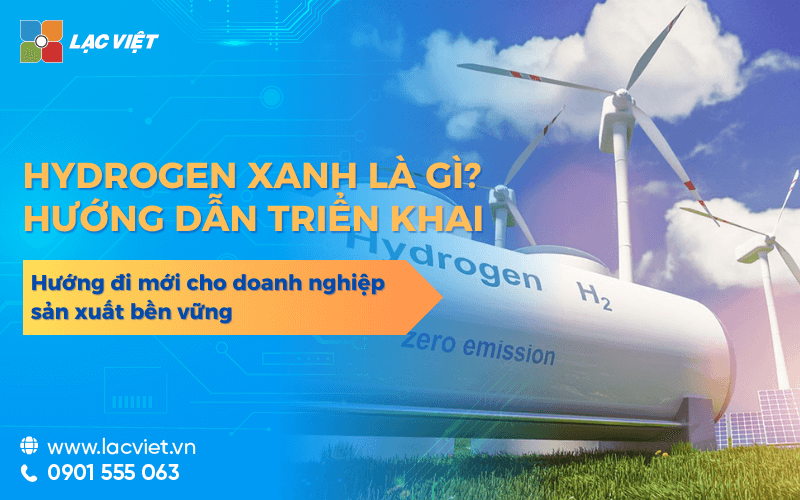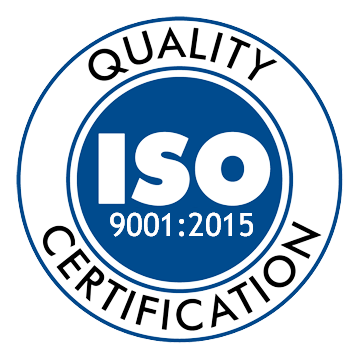In the context of energy conversion, global, going strong, the business is no longer standing outside the game when it matters emissions carbon, standard ESG supply chain and green has become the key element in evaluating the effectiveness sustainable business. Among many solutions current technology, hydrogen blue (green hydrogen) emerged as a selection strategy breakthrough – not only because of the potential emission reduction of the level to almost zero, but also because of the possibility of wide application in many industries key.
However, to properly understand to implement effective hydrogen, green businesses need to look at not only under a technical perspective, but also in aspects of performance, cost, infrastructure, and especially the opportunity to participate in the global value chain is shifting towards sustainable development. This article Lac Viet Computing will provide a comprehensive view of the hydrogen and green from the concepts, benefits, practices, applications in production to strategy deployment in accordance with the conditions of business in Vietnam.
1. Hydrogen what is green? Why business need care?
1.1 Workflow Definition
Hydrogen blue (green hydrogen) is a form of clean fuel is generated by electrolysis of water – i.e. separation water molecule (H₂O) of hydrogen gas (H₂) and oxygen (O₂) – use of electricity from renewable energy sources such as solar or wind. In this whole process, there are no greenhouse gases (CO₂) is born so that hydrogen is considered one of the solution energy “zero emissions”.
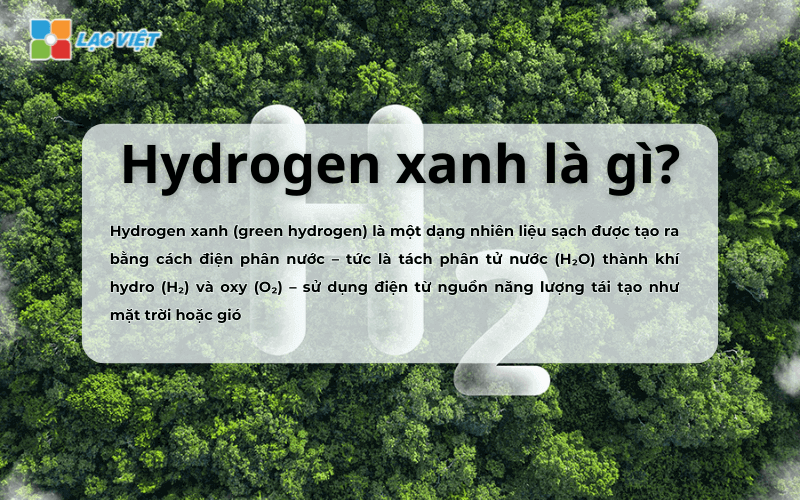
The important thing to distinguish is hydrogen not always “green”. There are three main forms:
- Hydrogen grey: produced from natural gas, cheap but emissions CO₂ big.
- Hydrogen blue: has technology capturing CO₂ comes emission reduction part.
- Hydrogen is generated from renewable electricity, does not cause greenhouse gas emissions in the production process.
With the characteristic “clean” potential replacement of fossil fuels, hydrogen green is becoming the pillars of strategy in the commitment to reach the level of emissions to net 0 (Net Zero) globally. Many countries such as EU, Japan, Korea, had a national strategy clearly on developing hydrogen blue to 2030 and 2050.
1.2 why businesses need to care about from now?
Because hydrogen blue is no longer the concept of bringing research that are step by step can be applied in industrial manufacturing, transportation, energy storage on a large scale. When the world shifted to the low carbon economy, the business pioneer approaches hydrogen blue soon will:
- Pick top trends in clean energy
- To reduce dependence on fossil fuel has cost, high risk
- Participate in global supply chain with competitive advantage pronounced
If businesses don't start to learn from now, will likely be left behind when the specified policy, carbon tax, requires ESG from international partners increasingly tightened.
- System monitoring what is energy? The optimal solution to help businesses save energy
- GHG Protocol what is? Implementation guide standard measurement international for business
- ISO 14064 is what? Detailed instructions building system standards credits carbon international
- Products what is green? Examples of green products in Vietnam
2. The method of producing hydrogen and current position of hydrogen blue
Hydrogen is considered as one of the sources of energy flexibility potential for the future, but not the kind of hydrogen would also have the level of environmental friendliness alike. The clear distinction between the method of producing hydrogen will now help businesses identify the right investment roadmap, avoid misunderstandings in the process of transition to clean energy.
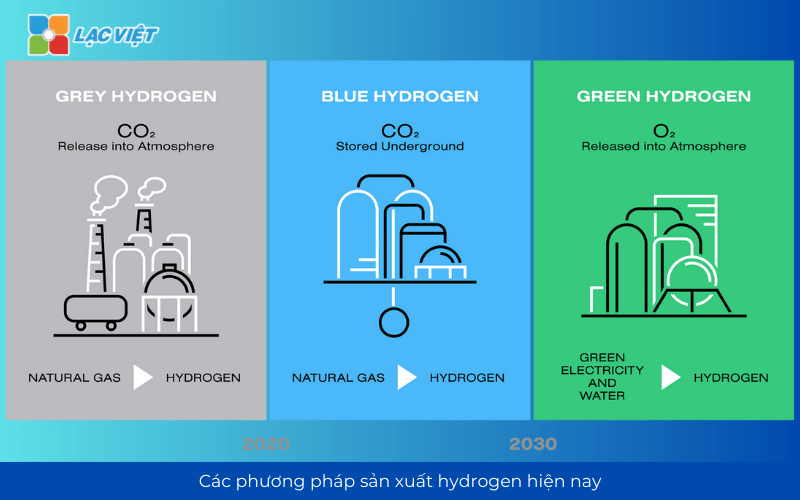
2.1. Hydrogen gray (Grey Hydrogen)
This is a method of producing today's most popular, accounting for more than 70% of hydrogen globally. Hydrogen grey is created through the process of processing natural gas (methane steam reforming) – that is, use heat, steam to separate hydrogen from methane.
However, the biggest problem of this method is the emission of CO₂ very high. For every 1 ton of hydrogen grey produced it emits about 9-10 tons of CO₂. Therefore, despite the low cost of production, hydrogen grey does not meet the requirements to reduce emissions of climate programs and does not fit with the business are geared to international standards of credits carbon.
Practical examples: A plant using hydrogen gray fuel will be charged the emissions indirectly in reported GHG (Greenhouse Gas) affect only the number of ESG, the ability to engage in sustainable supply chain.
2.2. Hydrogen blue (Blue Hydrogen)
Hydrogen blue are also produced from gasification of fossil fuels such as coal or natural gas but there is more technology seizure and storage of CO₂ (CCS – Carbon Capture and Storage) to reduce emissions given environment.
- Advantages: lower emissions compared to hydrogen gray, the cost is still relatively low.
- Limitations: Despite capturing technology, but the amount of CO₂ not been completely removed. Added to that, the storage of CO₂ long is also the problem of cost and infrastructure. This makes hydrogen blue only solution is transitional, not the direction of the optimal long-term for the business set goals for sustainable development really.
2.3. Hydrogen blue (Green Hydrogen)
Hydrogen blue is the type of hydrogen only does not arise greenhouse gases in the production process, thanks to be created from the process of electrolysis of water using renewable electricity (wind, solar, hydro...).
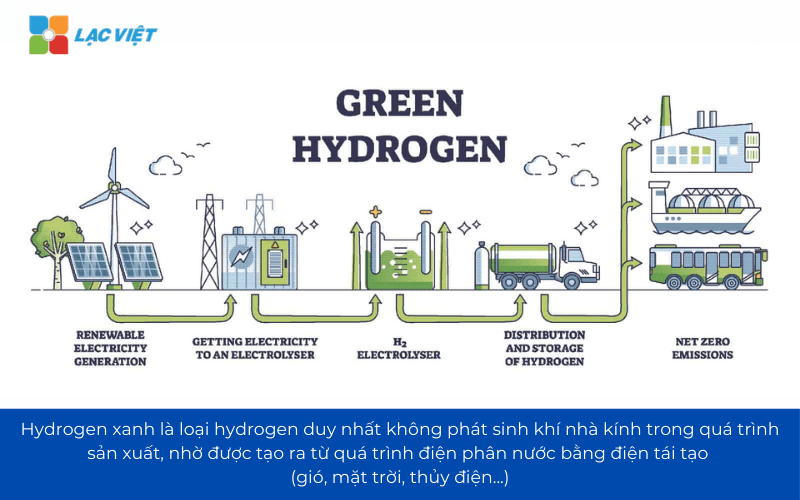
Simple mechanism: electric current is used to split water (H₂O) into hydrogen (H₂) and oxygen (O₂). Because of not using fossil fuels, so the whole process not born CO₂.
Clear benefits for business:
- Can recorded emissions equal to 0 in reported GHG
- Be considered as positive factors in assessing ESG helps to increase the opportunity to access investment funds green
- Demonstrate commitment to sustainable development in a transparent way, there is real value
Developed countries such as Germany, Japan, south Korea has taken hydrogen blue into the strategic national energy by 2050. The European union set the goal of producing 10 million tons of hydrogen green by 2030 to serve the industrial, transportation, clean.
Position of hydrogen green strategy in business: With characteristic zero emissions and the ability to replace fossil fuels in many industries, hydrogen not only is the trend, which is becoming an integral part of the strategy, production management, emission of business. This option is suitable for the unit like:
- Re-structure the system internal energy
- Optimize the cost of carbon in the long term
- Enhance competitive position in the global supply chain
3. App hydrogen blue in industrial and production
Hydrogen blue is not only a source of clean energy which is also a solution key to the industrial enterprises transition to the models produced lower emissions. With the ability to replace fossil fuels in many areas, hydrogen, blue is taking steps to assert his role in the roadmap for sustainable development in many key industries.
3.1. In the steel industry: Replace coal gas coke, reduce emissions up to 90%
The steel industry is one of the industry's emissions of the world's largest free to use coal gas coke to remove oxygen in the iron ore. This is the creation of CO₂ very big. Hydrogen blue can replace the role of coal gas in the forging process by the method of reductive oxygen with hydrogen to create water vapor instead of CO₂.
Enterprise value received:
- Up to 90% of greenhouse gas emissions in the production process of steel
- Enhance the ability to meet the standards of ESG criteria and “steel blue” are requested in European market
- Create advantage when participating in the global supply chain, particularly in the field of construction and automotive, where product requirements, environmentally friendly growing
For example, A number of large steel producers in Europe, such as SSAB (Sweden) began commercialization of steel is produced entirely by hydrogen blue.
3.2. In the transport sector: clean Fuel for trucks, marine, aviation
Hydrogen blue, when combined with fuel cell (fuel cell), can provide power for the means of transport without greenhouse gas emissions. Compared with battery electric, hydrogen technology had the advantage of the reload time, fast and scope to move away, especially suitable for heavy transport, such as long distance truck, ship or plane.
Enterprise value received:
- To reduce dependence on fossil fuels
- To comply with the new regulation on emission limit CO₂ for means of transport
- Increased accessibility policies to support green financing, particularly in logistics and aviation
The transition team transport car or invest in vehicles powered by hydrogen do not need to make en masse, which business can start from the fixed route or area of operation focus, reduce risk, the initial cost.
3.3. In the chemical industry: Raw material for production of ammonia, methanol blue
Hydrogen is the basic component in the production of ammonia – an important raw material for fertilizers, and methanol – raw material for plastic industry, textile, fuel. Today, these chemicals are mainly produced from hydrogen gray (high emission). The move to use hydrogen blue helps to reduce emissions significantly in the whole chain of production chemicals.
Clear benefits:
- Meet the requirements of chemical products “green” from export markets
- Contributed to branding chemical environment friendly
- Increased ability to engage in market, credit, carbon if you can prove effective emission reduction
3.4. In energy storage: Balance the grid using renewable energy
Hydrogen blue is not just a fuel source, but also as storage solution for energy efficiency. When production of electricity from solar or wind exceeds demand, the excess can be used for water electrolysis to create hydrogen. Then, hydrogen, this can be long-term storage and re-use when needed, help reduce the load pressure for the grid and increase the extraction performance of renewable energy.
Business can apply how?
- In the industrial area or factory using solar power, hydrogen blue may be the solution energy storage backup
- The initiative in energy use instead of depending entirely on the national grid
- Stable operating costs thanks to take advantage of excess power during off-peak periods
4. The situation developed hydrogen blue world and opportunities for Vietnamese businesses
Hydrogen blue is now considered to be one of the important pillars in the strategic transformation of global energy. Not only is the solution reduce greenhouse gas emissionshydrogen blue are also expected to gradually replace fossil fuels in industry, transport and energy storage.
Trend flourished globally
- Germany has committed to spending more than 9 billion euros for strategy hydrogen countries, in which the majority for production and import of hydrogen blue.
- Japan and south Korea aims to become a national leader in the commercialization of technology use hydrogen blue for the transport industry, heavy industry.
- Australia is taking advantage of solar power to become the center of exports of hydrogen blue for Asian teen with a series of large-scale projects have been implemented.
- The European union (EU) has announced plans to produce 10 million tons of hydrogen green by 2030 and additional budget to support businesses through the Climate Fund.
All the countries and regions mentioned above not only investment but also set ecosystems support hydrogen and green from the policy infrastructure to the financial system.
Opportunity for Vietnamese businesses
Vietnam, however, go back in the field, but possessed natural advantages superior about renewable energy – background elements to produce hydrogen blue:
- Productivity high solar radiation in Central – South
- Potential of wind power in coastal, Central – southwest
- Geographical position convenient for export hydrogen blue to the market are in great demand as Japanese and Korean
In addition, The state also has been taking steps to improve the legal framework for the field of hydrogen:
- Planning national energy up to 2050 has taken hydrogen blue into the category strategy development
- Ministry of Industry and Trade are building strategy Hydrogen countries, which refers to the business support, access to technology, finance
With this trend, Vietnamese enterprises – especially in the manufacturing industry, industrial, chemical, and transport – can fully take advantage of the opportunity to go ahead in the new market segment, from which affirmed its position in the supply chain sustainable global.
5. Actual benefits businesses receive when approaching hydrogen blue
The approach of hydrogen green not only bring about the benefits for the environment, but also bring economic value, operation, clear strategy for the business, especially in the areas of manufacturing, transport, energy and supply chain industry.
5.1. Compliance with the standards emissions, requires ESG global
In the period that the commitment to sustainable development (ESG) policies, emissions are becoming important criteria in trade cooperation, calling for investment capital, the use of hydrogen green will help businesses:
- Demonstrate efforts to reduce emissions have clear base
- Meet the requirements of the international partners are tightened criteria for carbon in the supply chain
- Contribute to finishing the report, sustainable development, transparency, reliable
5.2. Expanded accessibility to green financing, investment incentives
Financial institutions, investment funds, development as IFC, ADB, or the development bank is funding priority for the business application of clean technologies, especially the solutions related to hydrogen blue. This means:
- Businesses have the opportunity to access capital with preferential interest rates
- Can participate in the program, financial support green non-refundable
- Increase credit score for the loan application, call equity
5.3. Optimal operation and reduce the risk cost of carbon in the near future
Carbon tax cross-border (CBAM) is gradually applied in many big markets such as Europe. With the business of export production, the continued use of fossil fuels will lead to:
- Rising input costs
- Reduce the competitive advantage on price
- Faced with legal risks, the new tariff
Conversely, if the use of hydrogen blue – especially in the process of replacing natural gas, diesel, or coal – business will:
- Proactive cost control carbon
- Optimize the emission in reported GHG/ESG
- Have position to negotiate better with partners, investors
5.4. Capacity, competitive brand positioning, green
In the era of consumers, partners, and society are interested in sustainable value, the switch to use hydrogen blue is a pledge of strong, clear action. This helps businesses:
- Build brand image pioneering responsible with the environment
- Increase in brand value in the eyes of investors, international markets
- Easily access the market have standard high environmental
As reported by the IEA in the year 2023, the business is investing in hydrogen blue from an early stage will have a competitive advantage markedly in the global supply chain by 2030, particularly in heavy industry and international transport.
- Industrial what is green? Characteristics of the field applied in Vietnam
- What is green energy? Benefits of different types of green energy for business
- Credits Carbon is what? Market and form purchase and sale of only carbon
- EIA is what? The process of making records assessment report environmental impact
6. Businesses need to prepare what to incrementally deploy hydrogen blue?
The deployment of hydrogen blue not a story of “a step is done”. This is the process that need strategic thinking long-term, are divided into clear steps, in accordance with the actual capacity of each business. Here is the practical action to start in the right direction.
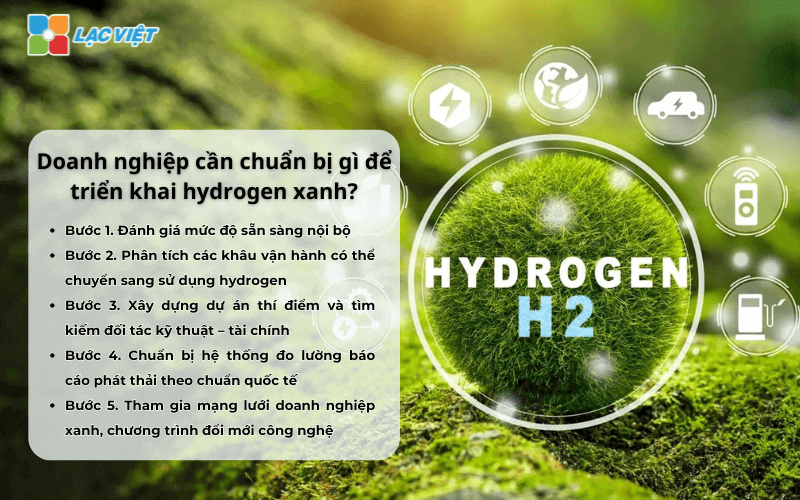
Step 1. Assess the level of readiness internal
Before investing, business need:
- Consider the possibility of using renewable energy is available or the possibility of new investment
- Assess the technical competence of the team, availability, conversion in the production process
- Determine the cost of the initial investment, life cycle financing of the project and ability to access capital
This helps businesses avoid investment, lack of focus, ensuring the feasibility of deployment.
Step 2. Analysis of the stitching operation can switch to using hydrogen
Not the whole system needs to switch at the same time. Businesses should:
- Mapping the sequence of internal energy, identify where the stitching can replace fossil fuels with hydrogen blue
- Priority areas are the high energy consumption or operating costs to pilot ago
For example, a plant can start by replacing the fuel gas for the boiler in the main workshop, instead of converting the entire system.
Step 3. Construction pilot project and search for the technical – financial
One of the most viable ways to deploy hydrogen blue is start from small projects, to have better control. Business can:
- Cooperation with the company, renewable energy to use power clean service water electrolysis
- Search unit to provide technology and equipment for power distribution in accordance with the scale of production
- Work with investment funds, green, organized international support in order to reach the capital deals or technical support
Step 4. Prepare measurement system for emissions reporting according to international standards
Use hydrogen blue is not only beneficial to the fact that there should be expressed in specific numbers of reported emissions. Businesses should:
- Start building system for tracking greenhouse gas emissions standards GHG Protocol
- Reporting periodically to prove effective cut CO₂ after applying hydrogen blue
- Integrate this report on strategy ESG profile approaches credits carbon
Step 5. Join the network of green business program innovation technology
Participation in the network, association, industry, green or groups test study help business:
- Access the latest information on trends, technology, policy
- Connect with experts, suppliers, partners deploy
- Share practical experience, reduce risk when deployed on a large scale
The approach hydrogen blue not only beneficial in terms of reducing emissions, but also helps businesses increase the accessibility of capital, green, enhance competitiveness, and actively adapt to the change in the policy of international trade. More importantly, here is the step shown long-term vision – to lay the foundations for a system operating efficiency, sustainability and deeper integration in the low carbon economy of the 21st century.

